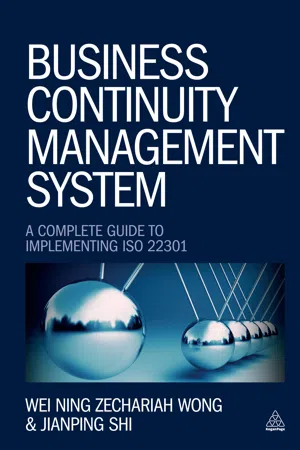
Business Continuity Management System
A Complete Guide to Implementing ISO 22301
- English
- ePUB (mobile friendly)
- Available on iOS & Android
Business Continuity Management System
A Complete Guide to Implementing ISO 22301
About this book
A business continuity management system (BCMS) is a management framework that prepares the organization by developing business continuity strategies to meet its business and statutory obligations during an incident. It is about optimizing service availability and preserving business performance to secure future growth in the market.
Business Continuity Management System offers a complete guide to establishing a fit-for-purpose business continuity capability in your organization. Structured in line with the principles of ISO22301 (the International Standard for business continuity management) and with current best practice, this user-friendly book covers the whole life cycle of developing, establishing, operating and evaluating a BCMS initiative. It is aimed at new and seasoned business continuity practitioners involved in business continuity activities in their organizations, whatever the size and sector. It includes proven techniques and easy-to-use methodologies that specifically support the implementation of those requirements specified in ISO 22301. Pragmatic approaches supported by in-depth explanations guide you to assess and improve your organization's BCMS performance. This is the first book to offer an end-to-end solution that addresses all aspects of implementing an effective BCMS.
Business Continuity Management System is intended to act as a catalyst to accelerate progress on the journey from business continuity management and risk management to the creation and implementation of a business continuity management system, both by enhancing the BCM and risk competence of individual readers and by contributing to shared knowledge in implementing ISO 22301 in organizations.
Frequently asked questions
- Essential is ideal for learners and professionals who enjoy exploring a wide range of subjects. Access the Essential Library with 800,000+ trusted titles and best-sellers across business, personal growth, and the humanities. Includes unlimited reading time and Standard Read Aloud voice.
- Complete: Perfect for advanced learners and researchers needing full, unrestricted access. Unlock 1.4M+ books across hundreds of subjects, including academic and specialized titles. The Complete Plan also includes advanced features like Premium Read Aloud and Research Assistant.
Please note we cannot support devices running on iOS 13 and Android 7 or earlier. Learn more about using the app.
Information
Table of contents
- Cover
- Title Page
- Imprint
- Contents
- Abbreviations
- List of tables
- List of figures
- Introduction
- 01. Fundamentals of business continuity management
- 02. Business continuity management system
- 03. Context of the organization
- 04. Leadership
- 05. Planning
- 06. Support
- 07. Operation
- 08. Performance evaluation
- 09. Improvement
- 10. Conclusion
- References
- Index
- Full Imprint